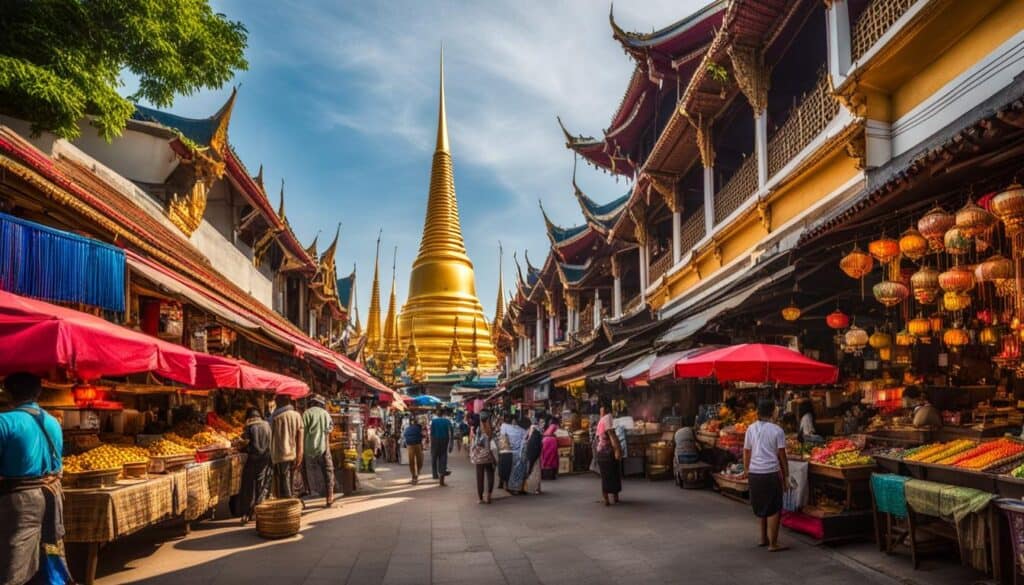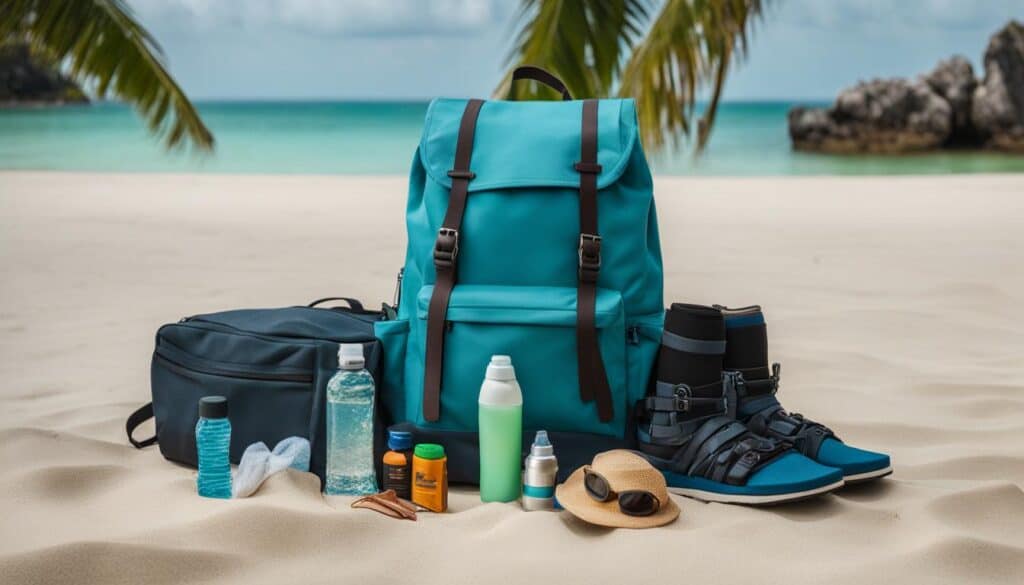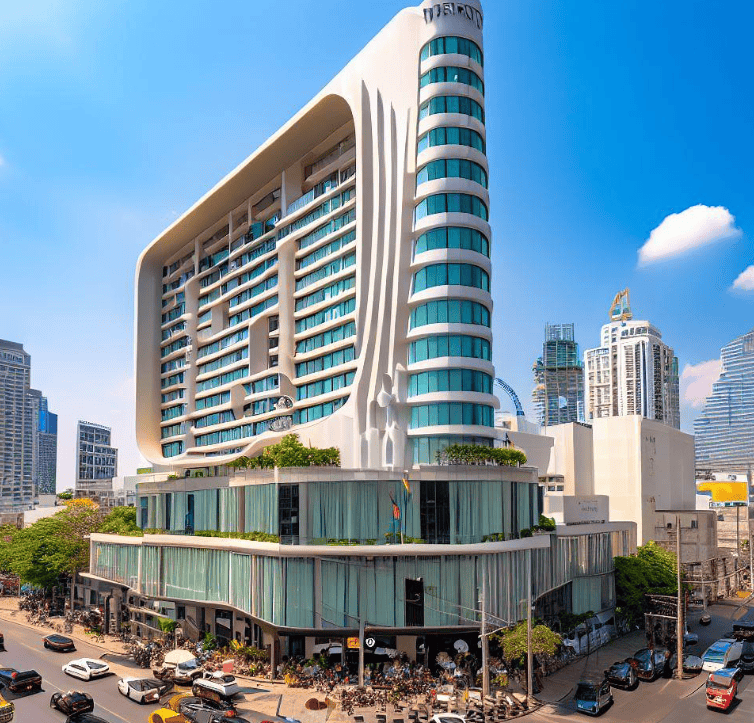
Have you ever dreamed of wandering through vibrant Thai markets, exploring ancient temples, or lounging on pristine beaches without a worry in the world? That was me, just a few years ago, eagerly planning my trip to Thailand on a shoestring budget. Determined to make every penny count, I embarked on an adventure that not only satisfied my wanderlust but also taught me invaluable lessons about budget travel.
One memorable evening in Bangkok, I stumbled upon a bustling night market. The aroma of sizzling street food filled the air as vendors showcased colorful trinkets and local crafts. I savored each bite of pad thai and mango sticky rice, realizing that these simple yet delicious meals cost less than my morning coffee back home. This experience underscored a key takeaway:
In This Article
- Key Tips for Budget Travel in Thailand
- 1. Understanding the Cost of Travel in Thailand
- 2. Affordable Accommodation Options
- 3. Navigating Transportation on a Budget
- 4. Enjoying Local Food Without Spending Too Much
- 5. Exploring Affordable Activities and Attractions
- 6. Timing Your Visit for Maximum Savings
- 7. Safety and Health Considerations While Traveling on a Budget
- 8. Smart Budget Planning Techniques
- 9. Engaging with Local Culture on a Budget
- 10. Bargain When Shopping
- Takeaways
- FAQ
- Helpful Reads
With careful planning and an open mind, you can have an amazing time in Thailand without draining your wallet.
Key Tips for Budget Travel in Thailand
| Key Tips | Description |
|---|---|
| Understanding the Cost of Travel | Knowing what to expect for daily expenses can help you budget effectively. |
| Affordable Accommodation Options | From cozy hostels to charming guesthouses, there’s always a place that fits your budget. |
| Navigating Transportation on a Budget | Whether it’s buses, tuk-tuks, or domestic flights, there are plenty of cost-effective ways to get around. |
| Savoring Local Cuisine | Street food is not only delicious but incredibly affordable. |
| Exploring Affordable Activities | Many attractions in Thailand are either free or very low-cost. |
| Timing Your Visit | Traveling during off-peak seasons can save you a lot of money. |
| Safety and Health Considerations | Staying safe and healthy doesn’t have to be expensive. |
| Smart Budget Planning Techniques | Utilize booking sites and manage daily expenses effectively. |
| Engaging with Local Culture | Immerse yourself culturally without spending much. |
| Bargain when Shopping | By embracing local haggling customs, you’ll save money and engage more deeply with Thai culture. |
1. Understanding the Cost of Travel in Thailand
Traveling in Thailand on a budget is not only possible but can be quite comfortable with some savvy planning. The cost of living in Thailand is relatively low, allowing you to explore this beautiful country without breaking the bank. But what does a $25/day budget in Thailand actually look like?
Typical Daily Expenses Breakdown
Here’s a snapshot of what you might spend daily:
- Accommodation: Budget accommodations, such as hostels or guesthouses, range from $5 to $10 per night.
- Food: Enjoying local street food and affordable restaurants typically costs between $5 to $7 per day.
- Activities: Visiting temples, local markets, and parks can be free or cost around $3 to $5 for entry fees.
Combining these expenses, you can easily manage on $20-$25 per day.
Budgeting for a Month-Long Trip
Let’s break down the estimated costs for a month-long adventure:
- Accommodation: Assuming you stay at budget places averaging $8 per night, you’ll spend about $240 for the month.
- Food: Eating delicious Thai cuisine at street vendors or local eateries will set you back roughly $180 ($6/day).
- Transportation: Using public transport like buses and trains might cost around $50.
- Activities and Miscellaneous: Budget an additional $100 for entrance fees, occasional splurges, and other small expenses.
This brings your total to approximately $570 for a month, leaving room to enjoy some extra activities or souvenirs.
Useful Resources
For more tips on saving money during your travels, check out our Ultimate Guide to Saving Money at the Airport.
Thinking of an extended vacation? Our Guide to Choosing the Best Luggage might come in handy.
By understanding these typical costs and planning accordingly, you’ll find that your dollar stretches far in Thailand. Exploring this vibrant country on a budget not only enriches your experience but also allows you to connect more deeply with its culture and people.
2. Affordable Accommodation Options
Finding cheap accommodation in Thailand isn’t just possible—it’s a delightful part of the adventure! Whether you’re wandering through the bustling streets of Bangkok or soaking in the serene vibes of Chiang Mai, there are plenty of budget-friendly places to stay that don’t skimp on comfort or charm.
Types of Budget Accommodations
1. Hostels
A staple for budget travelers. Hostels in Thailand are not only affordable but also offer a great way to meet fellow adventurers. Many hostels provide amenities like free Wi-Fi, communal kitchens, and even organized tours.
Personal Recommendation: Lub D Bangkok Siam is one I loved for its vibrant atmosphere and proximity to major attractions.
2. Guesthouses
These are often family-run establishments that give you a more intimate experience. Guesthouses tend to be slightly quieter than hostels and can offer private rooms at very reasonable prices.
Personal Recommendation: Julie Guesthouse in Chiang Mai offers cozy rooms and an incredibly welcoming staff.
Average Prices and Prime Locations
1. Chiang Mai
Known for its laid-back vibe and rich culture, Chiang Mai is a haven for budget travelers.
- Hostel Prices: Average around $5-$10 per night.
- Prime Locations: The Old City is peppered with affordable options close to must-see temples and markets.
2. Bangkok
The city’s frenetic energy is matched by its wide range of budget accommodations.
- Hostel Prices: You can find decent hostels ranging from $7-$15 per night.
- Prime Locations: Khao San Road is famous for its backpacker-friendly options, while Sukhumvit offers slightly pricier but still affordable stays.
Looking for specific recommendations? Check out our list of decently cheap hotels in Bangkok with good ratings!
Tips for Scoring the Best Deals
- Booking Platforms: Websites like Booking.com, Hostelworld, and Agoda often have unbeatable deals. Keep an eye out for last-minute discounts!
- Flexible Dates: If your schedule allows, being flexible with your travel dates can help you snag lower rates.
- Direct Bookings: Sometimes booking directly through the hostel or guesthouse’s website can get you additional perks like free breakfast or discounted tours.
Embrace the opportunity to stay in unique places that add flavor to your journey without emptying your wallet. With plenty of cheap accommodation in Thailand available, you’re sure to find a spot that feels just right for your adventure!
3. Navigating Transportation on a Budget
Getting around Thailand on a budget is easy if you know your options. Here’s how I managed to move from bustling cities to serene beaches without spending a fortune.
Public Transportation in Thailand
Thailand offers a variety of transportation options that are both efficient and affordable:
- Buses: In cities like Bangkok and Chiang Mai, buses are the backbone of public transportation. The fares are incredibly cheap, often costing just a few baht for a ride across town. Long-distance buses are also an economical way to travel between cities. Companies like Nakhonchai Air and Green Bus provide comfortable journeys at reasonable prices.
- Taxis: While more expensive than buses, taxis can still be quite affordable, especially if you’re traveling with companions. Always insist on using the meter or negotiate a price before starting your trip.
- Tuk-tuks: These three-wheeled wonders are iconic in Thailand. They’re great for short trips around town but can be pricier compared to buses. Always haggle to get the best rate.
Domestic Flights in Thailand
Flying within Thailand doesn’t have to break the bank. With budget airlines like AirAsia, Nok Air, and Thai Lion Air offering competitive rates, domestic flights become a viable option for long-distance travel.
Cost Comparison and Tips
- Buses vs. Flights: For shorter distances (e.g., Bangkok to Pattaya), buses are more cost-effective. For longer routes (e.g., Bangkok to Phuket), budget flights can save time without significantly increasing costs.
- Booking Tips:
- Advance Booking: Snagging deals is all about timing. Book flights at least a month in advance for the best prices.
- Flexible Dates: Use fare comparison tools like Skyscanner or Google Flights to find the cheapest days to fly.
- Promotions: Keep an eye out for flash sales and promotions from budget airlines.
Navigating transportation doesn’t just end with choosing the right mode; it also involves being prepared for potential mishaps. Check out our guide on cheap travel insurance to ensure you’re covered during your travels.
Traveling by land or air in Thailand can be as adventurous as it is budget-friendly when you plan smartly and stay flexible.
4. Enjoying Local Food Without Spending Too Much
Exploring the colorful world of street food in Thailand is like going on a delicious adventure that won’t cost you much. The wide range of flavors and dishes offered at street stalls and local restaurants make it not only a budget-friendly option but also an unforgettable experience.
Why You Should Try Street Food and Local Restaurants
- Authenticity: Eating local food in Thailand allows you to taste the heart and soul of Thai culture. Dishes are prepared with traditional recipes passed down through generations.
- Affordability: Street food is incredibly cheap. Most dishes range from 30 to 100 THB ($1 to $3), making it easy to stick to your budget while enjoying delicious meals.
- Convenience: Street food vendors are everywhere—from bustling markets to quiet alleyways—so you’re never far from a great meal.
- Variety: From aromatic pad thai to spicy som tam (green papaya salad), there’s always something new and exciting to try.
Average Meal Costs and Must-Try Dishes
During my travels, I found that eating like a local saved me a significant amount of money. Here’s a quick rundown of average meal costs and some must-try dishes:
- Pad Thai: Around 40–60 THB ($1.20–$2)
- Som Tam: Approximately 30–50 THB ($1–$1.50)
- Tom Yum Goong (Spicy Shrimp Soup): Typically 50–80 THB ($1.50–$2.50)
- Mango Sticky Rice: Usually around 50–70 THB ($1.50–$2)
Each of these dishes left a lasting impression on my taste buds. For instance, the rich flavors of Tom Yum Goong combined with its spicy kick made it a favorite comfort food.
Exploring local markets like Chatuchak Weekend Market in Bangkok or the Night Bazaar in Chiang Mai offers endless culinary delights at unbeatable prices.
Savoring street food in Thailand is not just about eating; it’s about experiencing the country’s vibrant culture through its incredible cuisine, all while keeping your travel budget intact.
5. Exploring Affordable Activities and Attractions
Thailand is full of affordable activities and attractions that will make your trip unforgettable without emptying your pocket. Here are some of the must-see low-cost or free attractions I enjoyed.

Low-Cost or Free Attractions
Temples
Thailand is known for its beautiful temples, which are often free or have a small entrance fee. Here are a few highlights:
- Wat Pho in Bangkok: Home to the Reclining Buddha, it’s an iconic spot you can’t miss.
- Wat Phra Singh in Chiang Mai: Known for its classic Lanna architecture, it’s a peaceful escape in the city.
- Wat Arun along the Chao Phraya River: Offers stunning views, especially during sunset.
National Parks
If you love nature, Thailand’s national parks are a paradise.
- Khao Sok National Park: A lush rainforest with budget-friendly accommodation options like floating bungalows.
- Erawan National Park: Famous for its seven-tiered waterfall, it’s perfect for a day hike and swim.
- Doi Inthanon National Park: The highest peak in Thailand offers cool weather and picturesque landscapes.
Markets
Immerse yourself in local culture by visiting lively markets where you can find everything from street food to souvenirs.
- Chatuchak Weekend Market in Bangkok: One of the largest markets in the world, offering endless exploration without spending much.
- Sunday Walking Street in Chiang Mai: A vibrant market with local crafts, food stalls, and live performances.
Unique Experiences
Cooking Classes
Learning to cook Thai cuisine is both fun and affordable. Many places offer classes at reasonable prices.
During my stay in Chiang Mai, I joined a half-day cooking class for about $30 USD. We visited a local market to shop for ingredients and learned to prepare classic dishes like Pad Thai and Green Curry.
Local Festivals
Participating in festivals is a fantastic way to immerse yourself in Thai culture without spending much.
- Songkran (Thai New Year): Celebrated in April, this water festival involves joyful water fights across the country. It’s free to join and an absolute blast!
- Loy Krathong: Held in November, this festival features beautiful lantern releases and floating candle-lit offerings on rivers.
Community Projects
Engaging in volunteer work can provide profound cultural insights while being cost-effective.
Options range from teaching English to helping out at elephant sanctuaries. These experiences often come with minimal costs while giving back to local communities.
These activities not only enrich your travel experience but also allow you to connect deeply with Thai culture without breaking the bank.
6. Timing Your Visit for Maximum Savings

Peak vs. Low Seasons and Their Effects on Pricing
Traveling to Thailand is all about timing. Based on my experiences, understanding the peak and low seasons can significantly impact your budget.
1. Peak Season (November to February)
This is when Thailand experiences its cool, dry season. It’s an absolutely beautiful time to visit, but be prepared for higher prices in accommodation and flights since it’s the most popular time among tourists.
2. Low Season (July to September)
Known as the rainy season, this period sees fewer tourists. While it might sound less appealing due to frequent showers, it’s actually a fantastic time for budget travelers. Prices drop dramatically, making everything from accommodations to activities much more affordable.
Pro Tip: A bit of rain never hurt anyone! Pack a lightweight rain jacket and embrace the lush green landscapes that come alive during the monsoon.
Best Months for Budget Travel
If saving money is high on your list, consider planning your trip between July and September. Here’s why:
- July: The rains begin, but they are usually short-lived. This month kicks off the low season with plenty of discounts.
- August: Heavy rains continue, but you can nab some incredible deals on hotels and tours.
- September: Towards the end of the rainy season, prices remain low while the weather starts improving.
Besides cost savings, traveling during these months allows you to experience unique local festivals:
- Asanha Bucha Day (typically in July): This Buddhist festival marks Buddha’s first sermon.
- Mother’s Day (August 12): Celebrated nationwide in honor of Queen Sirikit’s birthday with parades and cultural performances.
Curious about when to plan trips to other destinations? Check out our guide on the best time to visit Vietnam for more insights.
Embracing Seasonal Events
Attending local events during these quieter months can enrich your travel experience without adding much to your expenses:
- Boon Bang Fai Rocket Festival: Held in May or June, this festival involves launching homemade rockets into the sky—a thrilling sight!
- Khao Phansa Day: Marks the start of Buddhist Lent in July with candle processions and temple ceremonies.
Packing for these adventures? Don’t miss our packing hacks for budget travelers to make sure you’ve got everything you need without overloading your bags.
By strategically timing your visit and embracing what’s unique about each season, you can make unforgettable memories in Thailand while keeping your wallet happy.
7. Safety and Health Considerations While Traveling on a Budget
Traveling in Thailand is an adventure, but it’s essential to stay safe and healthy. Here are some tips based on my personal experiences:
Street Food Hygiene Practices
Indulging in street food is one of the best ways to experience Thailand’s culinary delights without spending much. Yet, keeping hygiene in mind is crucial:
- Observe the Stall’s Cleanliness: Choose stalls that maintain good hygiene practices. A clean workspace often indicates clean food preparation.
- Watch for Fresh Ingredients: Opt for stalls where food is cooked fresh in front of you. This ensures the ingredients haven’t been sitting out for too long.
- Busy Stalls are a Good Sign: High customer turnover typically means fresher ingredients and better quality control.
Eating street food not only saves money but also immerses you in local culture. For more affordable eats around Asia, explore our Philippines Sightseeing Places guide.
Importance of Travel Insurance
Renting scooters or vehicles offers a lot of freedom but comes with its risks. Ensuring you’re covered by travel insurance can save you from hefty expenses:
- Coverage for Accidents: Make sure your insurance covers accidents involving rented vehicles. Medical costs can add up quickly if you’re not prepared.
- Personal Experience: I once had a minor scooter accident in Chiang Mai. Thanks to travel insurance, my medical expenses were taken care of, allowing me to continue my journey stress-free.
It’s always better to be safe than sorry, especially when traveling on a budget.
Additional Health Precautions
Beyond food hygiene and insurance, consider these precautions for a healthier trip:
- Stay Hydrated: Carry a reusable water bottle and refill it with filtered water to avoid dehydration.
- Insect Repellent: Mosquitoes can be pesky, especially in tropical areas. Use insect repellent to prevent bites.
- Basic First Aid Kit: Pack essentials like band-aids, antiseptic cream, and medication for common ailments.
Exploring Thailand doesn’t have to break the bank or compromise your health. By taking simple precautions, your trip can be both memorable and safe.
For more thrilling yet safe adventures, check out our Scotland Haunted Tours guide—just remember to pack wisely!
8. Smart Budget Planning Techniques
Planning is your best friend when it comes to budget travel in Thailand. Here are some tried-and-true methods that helped me stretch my baht without sacrificing the joy of exploration.
Using Booking Sites for Discounts
Booking sites are a goldmine for finding great deals on accommodations and transportation. Websites like Agoda, Booking.com, and Hostelworld often have exclusive discounts that can save you a significant amount.
- Accommodations: I frequently found deals on hostels and guesthouses, sometimes saving up to 40% by booking in advance or during flash sales.
- Transport: Skyscanner and 12Go Asia were essential tools for comparing prices on domestic flights, buses, and even trains. It’s worth checking these platforms regularly to snag the best rates.
Pro Tip: Sign up for newsletters from these booking sites to get notified of special promotions and last-minute offers.
Daily Expense Management Strategies
Managing daily expenses is key to staying within your budget. Here’s what worked well for me:
- Set a Daily Budget: Determine a fixed amount you’re willing to spend each day on essentials like food, transportation, and activities. For me, a daily budget of around $30 USD was sufficient.
- Use Cash Wisely: While ATMs are widely available, withdrawal fees can add up. I aimed to withdraw larger amounts less frequently and always carried smaller bills for street vendors.
- Track Your Spending: Apps like Trail Wallet or good old-fashioned pen and paper helped me keep track of my expenditures. This way, I could adjust my spending if I noticed I was nearing my daily limit.
Practical Tips
- Eat Like a Local: Dining at street food stalls not only provides an authentic taste of Thailand but also keeps costs low. A delicious meal can cost as little as $1-$2 USD.
- Leverage Public Transport: Utilize affordable public transport options like buses and trains for longer journeys instead of taxis or private cars.
For those looking to explore more budget-friendly routes in other parts of Asia, check out our guide on traveling from Taipei to Yilan by bus. You might find some useful tips that apply to your travels in Thailand too!
By incorporating these smart budget planning techniques, you’ll find it’s entirely possible to experience the magic of Thailand without breaking the bank.
9. Engaging with Local Culture on a Budget
One of the best parts about traveling to Thailand is immersing yourself in the vibrant local culture. And you don’t have to spend a fortune to do so! Many temples and historical sites offer free or low-cost entry, allowing you to explore the rich heritage of the country without straining your budget.
You will also want to keep an eye out for free or affordable cultural events like traditional dance performances or local festivals, which can provide a unique glimpse into Thai traditions and customs. So don’t be afraid to venture beyond the tourist hotspots and discover the true essence of Thailand on a shoestring budget.
Immersing Culturally Without Spending Much
Exploring cultural experiences in Thailand doesn’t have to break the bank. During my travels, I found several ways to immerse myself deeply into Thai culture without spending much:
- Cooking Classes: Taking a local cooking class is an amazing way to dive into Thai cuisine and culture. It often costs less than a fancy meal out and leaves you with skills and recipes to recreate back home. I joined a budget-friendly class in Chiang Mai where I learned to make Pad Thai and Green Curry.
- Volunteering Opportunities: Volunteering offers a unique opportunity to connect with local communities while traveling responsibly. Organizations across Thailand offer various programs from teaching English to working at animal sanctuaries. It’s a fulfilling experience that enriches your understanding of Thai life.
Festivals for Cultural Insights
Thailand’s vibrant festivals are another fantastic way to experience the local culture affordably. These events are full of color, tradition, and joy.
- Songkran (Thai New Year): Celebrated in mid-April, Songkran is known for its nationwide water fights. Participating in this festival is free and offers a fun, immersive experience. You’ll find yourself drenched in water as locals and tourists come together in a playful celebration of the new year. Loy Krathong, held in November, is another mesmerizing festival where people release beautifully-decorated floating lanterns into rivers and lakes, symbolizing letting go of negativity. These festivals offer unique cultural insights and are budget-friendly ways to connect with Thai traditions.
- Loy Krathong: Held on the full moon night of the 12th lunar month, Loy Krathong involves floating decorated baskets on rivers and lakes. It’s a beautiful and serene event that allows you to partake in traditional rituals without significant expense. Yi Peng: Another popular festival in Chiang Mai is Yi Peng, which coincides with Loy Krathong. During this event, thousands of sky lanterns are released into the night sky, creating a breathtaking display. Participating in these festivals not only immerses you in Thai culture but also provides a unique and unforgettable experience at an affordable cost.
For more inspiration on affordable cultural experiences, check out our tips for budget travel in New Zealand.
Soak up the rich cultural tapestry of Thailand by engaging with these budget-friendly activities. The memories you’ll create will be priceless!
10. Bargain When Shopping
When you’re shopping in Thailand, bargaining is not just accepted—it’s expected. Whether you’re at bustling street markets or quaint local shops, haggling can help you get the best deals on everything from souvenirs to clothing.
Remember to approach bargaining with a friendly and respectful attitude. Start by offering a lower price than what you’re willing to pay, and be prepared for some back-and-forth negotiation. Keep in mind that the goal is to reach a fair price that both you and the seller are satisfied with.
Key Tips for Bargaining:
- Start Low: Begin by offering about half of the initially quoted price. This gives you room to negotiate upwards.
- Stay Polite: Maintain a friendly and respectful tone throughout the process. Smiling and showing appreciation can go a long way.
- Know When to Walk Away: If the seller isn’t budging, don’t be afraid to walk away. Often, this will prompt them to offer a better price.
- Research Prices: Before you shop, try to get an idea of standard prices for items. This helps you know what’s reasonable.
- Be Realistic: While it’s fun to haggle, remember that sellers also need to make a living. Aim for a fair deal for both sides.
“Haggling is an art form in Thailand—master it, and you’ll enhance your shopping experience.”
Where to Bargain
Markets:
- Chatuchak Weekend Market (Bangkok): This iconic market is one of the largest in the world, with over 15,000 stalls. It’s an excellent place to hone your bargaining skills as you navigate through endless aisles of clothing, accessories, antiques, and unique souvenirs.
- Warorot Market (Chiang Mai): Known for its variety of local goods and vibrant atmosphere, this market offers everything from fresh produce to traditional Thai textiles. It’s a great spot to engage in friendly negotiations with local vendors.
Night Bazaars:
- Chiang Mai Night Bazaar: A bustling hub of activity every evening, this bazaar stretches along several city blocks. You’ll find an array of handcrafted items, artwork, and local delicacies. Sellers here are accustomed to haggling, so don’t shy away from starting a negotiation.
- Phuket Weekend Night Market: Also known as Naka Market, this lively night market features a mix of second-hand goods, curiosities, and a wide range of street food. The dynamic environment makes it a perfect place to practice your bargaining tactics.
Beach Vendors:
- Patong Beach (Phuket): While soaking up the sun on this famous beach, you’ll encounter vendors offering everything from cold drinks to handcrafted jewelry. Bargaining is common and can lead to some great deals.
- Pattaya Beach: Vendors here sell a variety of items including snacks, beachwear, and souvenirs. Engaging in polite negotiation can make your beach day even more enjoyable.
By embracing the local customs of haggling, not only will you save money, but you’ll also engage more deeply with Thai culture.
Don’t hesitate to negotiate prices at markets – start with half the price and work your way up.
Remember, haggling is a part of the culture!
Takeaways
Budget holidays to Thailand can still be filled with unforgettable experiences. From my own adventures, I can assure you that with a bit of savvy planning and an adventurous spirit, you can explore this stunning country without overspending.
Embrace the Adventure
Thailand’s diversity—from busy cities to peaceful beaches—offers endless opportunities for exploration, even on a backpacker budget. Here are some final words of encouragement:
- Stay Flexible: Embrace spontaneity. Last-minute deals and off-the-beaten-path destinations often yield the best experiences.
- Connect with Locals: Engage in conversations with residents. They often know the best hidden gems and can offer insights that guidebooks miss.
- Prioritize Experiences Over Luxuries: Focus on activities that create lasting memories rather than costly comforts. A street food tour or a visit to a local festival can be more enriching than fancy dining.
Your Budget Travel Toolbox
For those looking to dive deeper into smart travel strategies, check out our Budget Travel Guide: How to Travel on a Budget. This guide is packed with tips on finding cheap flights, frugal accommodations, and much more.
If Thailand has piqued your interest in Asia, you might also want to explore our guide on the Best Time to Visit Taiwan. Discover how to experience Taiwan’s stunning landscapes and cultural events without breaking the bank.
Join Our Community
We’re more than just a website; we’re a community of like-minded travelers sharing real-world experiences. Join us at Thrifty Escapades to swap stories, share advice, and inspire each other’s journeys. Together, we can make budget travel not only possible but incredibly rewarding.
FAQ
Question 1
What is the best time of year to travel to Thailand on a budget?
Best Time of Year to Travel to Thailand on a Budget
Traveling to Thailand on a budget can be an exciting experience, especially if you choose the right time of year. Here’s a breakdown of the seasons and the best times to visit:
1. Low Season (May to October)
- Pros:
- Lower Prices: Accommodation and flights are often cheaper.
- Fewer Tourists: Popular attractions are less crowded, allowing for a more relaxed experience.
- Rainy Season: While it rains, it usually comes in short bursts, leaving plenty of dry time for activities.
- Cons:
- Weather: Expect higher humidity and occasional heavy rain, especially in September and October.
2. Shoulder Season (November to February)
- Pros:
- Pleasant Weather: Cooler temperatures and less humidity make for enjoyable sightseeing.
- Festivals: Experience local festivals such as Loy Krathong (usually in November) and New Year celebrations.
- Moderate Prices: Prices are generally lower than the peak season, especially if you book in advance.
- Cons:
- Increasing Crowds: Popular tourist spots can get busy, especially around Christmas and New Year.
3. Peak Season (December to January)
- Pros:
- Best Weather: This is the most comfortable time to explore Thailand, with sunny days and cooler evenings.
- Festive Atmosphere: Enjoy vibrant celebrations and events.
- Cons:
- Higher Costs: Prices for flights and accommodations can skyrocket due to demand.
Question 2
Are there any budget travel apps or websites specifically for Thailand?
Budget Travel Apps and Websites for Thailand
When planning a budget trip to Thailand, there are several apps and websites that can help you find the best deals on accommodation, transportation, and activities. Here’s a list of some useful resources:
1. Accommodation
- Agoda:
- Offers competitive prices on hotels and hostels.
- Tip: Use the filter options to find budget-friendly accommodations.
- Booking.com:
- Great for comparing prices and finding deals on various types of lodging.
- Tip: Look for properties with free cancellation for flexibility.
- Hostelworld:
- Specializes in budget hostels, perfect for backpackers.
- Tip: Read reviews to find places with good amenities.
2. Transportation
- Rome2rio:
- Helps you find the best ways to travel between destinations in Thailand.
- Tip: Check multiple transport options like buses, trains, and flights.
- Grab:
- A ride-hailing app similar to Uber, great for getting around cities.
- Tip: Use GrabBike for cheaper transport in congested areas.
- 12Go Asia:
- Provides information on various transportation options, including trains and ferries.
- Tip: Book tickets in advance during peak seasons for better prices.
3. Activities and Experiences
- Klook:
- Offers discounts on attractions, tours, and activities.
- Tip: Look for bundle deals to save even more.
- GetYourGuide:
- Similar to Klook, with a variety of tours and experiences available.
- Tip: Read reviews to ensure quality experiences.
- Viator:
- Provides options for local tours and activities, often at reduced prices.
- Tip: Check for last-minute deals for spontaneous adventures.
4. Food and Dining
- Eatigo:
- Offers discounts at various restaurants in Thailand.
- Tip: Make reservations during off-peak hours for better deals.
- Tripadvisor:
- Useful for finding budget-friendly dining options based on reviews.
- Tip: Look for local eateries for authentic and affordable meals.
By utilizing these apps and websites, you can effectively manage your budget while enjoying all that Thailand has to offer.
Question 3
What budget travel tips do you recommend for first-time visitors to Thailand?
Budget Travel Tips for First-Time Visitors to Thailand
Traveling to Thailand on a budget can be an enriching experience, allowing you to enjoy the beauty and culture without breaking the bank. Here are some practical tips to help you make the most of your trip:
1. Plan Your Itinerary Wisely
- Research Destinations: Focus on a few key areas like Bangkok, Chiang Mai, and the islands (e.g., Koh Samui, Koh Phi Phi) to save on transportation costs.
- Use Local Transportation: Utilize buses, tuk-tuks, and songthaews (shared taxis) instead of taxis or private cars.
2. Accommodation Choices
- Stay in Hostels or Guesthouses: Look for budget-friendly options on platforms like Hostelworld or Booking.com.
- Consider Homestays: This can provide a more authentic experience and often includes meals.
3. Eating on a Budget
- Eat Street Food: Sample delicious local dishes from street vendors, which are often cheaper and tastier than restaurant meals.
- Local Markets: Visit markets for fresh fruit, snacks, and meals at lower prices.
4. Free and Low-Cost Activities
- Explore Temples: Many temples have low or no entrance fees. For example, Wat Pho and Wat Arun in Bangkok are must-visit sites.
- Nature and Parks: Enjoy Thailand’s beautiful national parks, which often have minimal entrance fees.
5. Shopping Smart
- Bargain at Markets: Don’t hesitate to negotiate prices at local markets like Chatuchak in Bangkok or night markets.
- Avoid Tourist Traps: Stick to local shops for souvenirs to find better deals.
6. Use Technology
- Travel Apps: Download apps like Grab for affordable rides and Google Maps for navigation.
- Currency Exchange: Use local ATMs for better exchange rates but be aware of fees.
7. Travel Off-Peak
- Visit During Low Season: Traveling during the rainy season (May to October) can save you money on flights and accommodation.
8. Stay Connected
- Get a Local SIM Card: This is often cheaper than international roaming and helps you stay connected for navigation and communication.
By integrating these tips into your travel plans, you can enjoy a fulfilling experience in Thailand without overspending.
Helpful Reads
- https://thriftytraveler.com/guides/travel/beginners-guide-thailand/
- https://medium.com/@asanaphuket/thrifty-adventures-a-guide-to-3-months-in-thailand-with-3-000-7776742f3e4e

Anne Thomas is a resourceful freelance writer with a passion for history and a knack for uncovering hidden gems on her global journeys. She roams the globe in search of untold stories and historical treasures without breaking the bank.
When she’s not deciphering ancient scripts or exploring archaeological sites, you can find her in a cozy library with a cup of tea, diving into old books and manuscripts from different eras.


